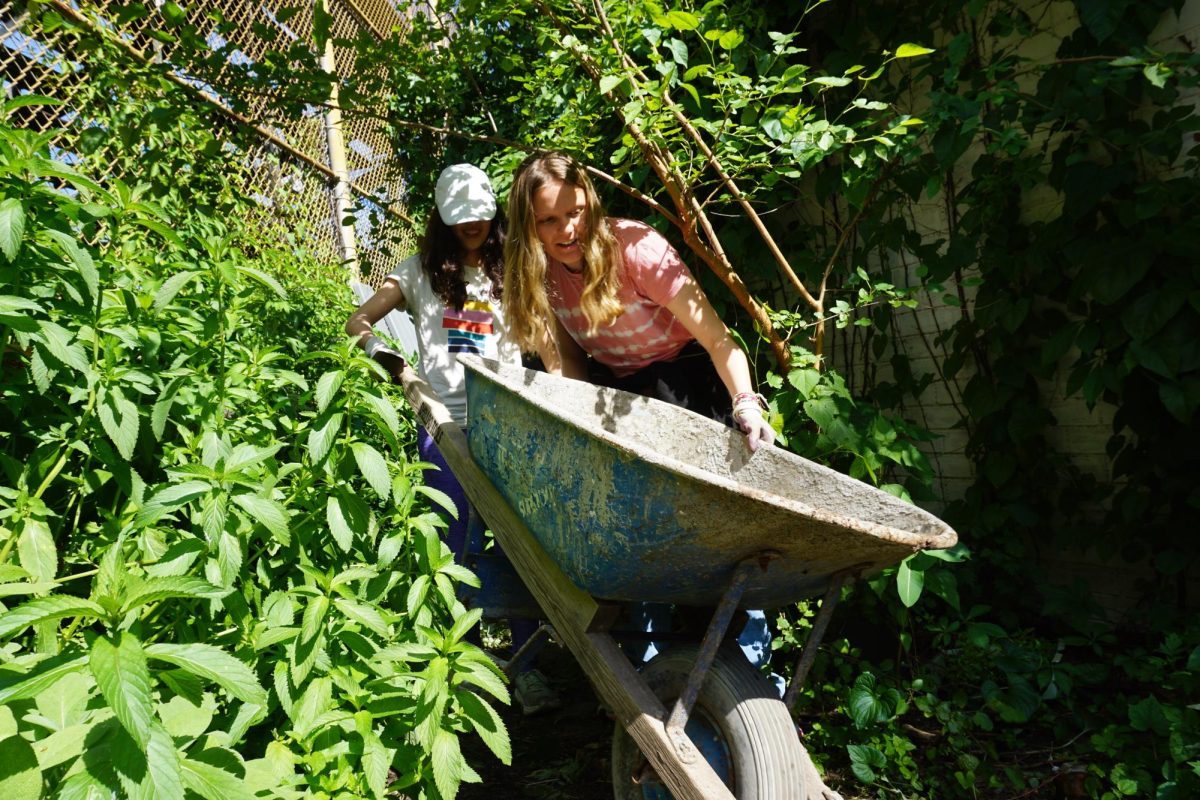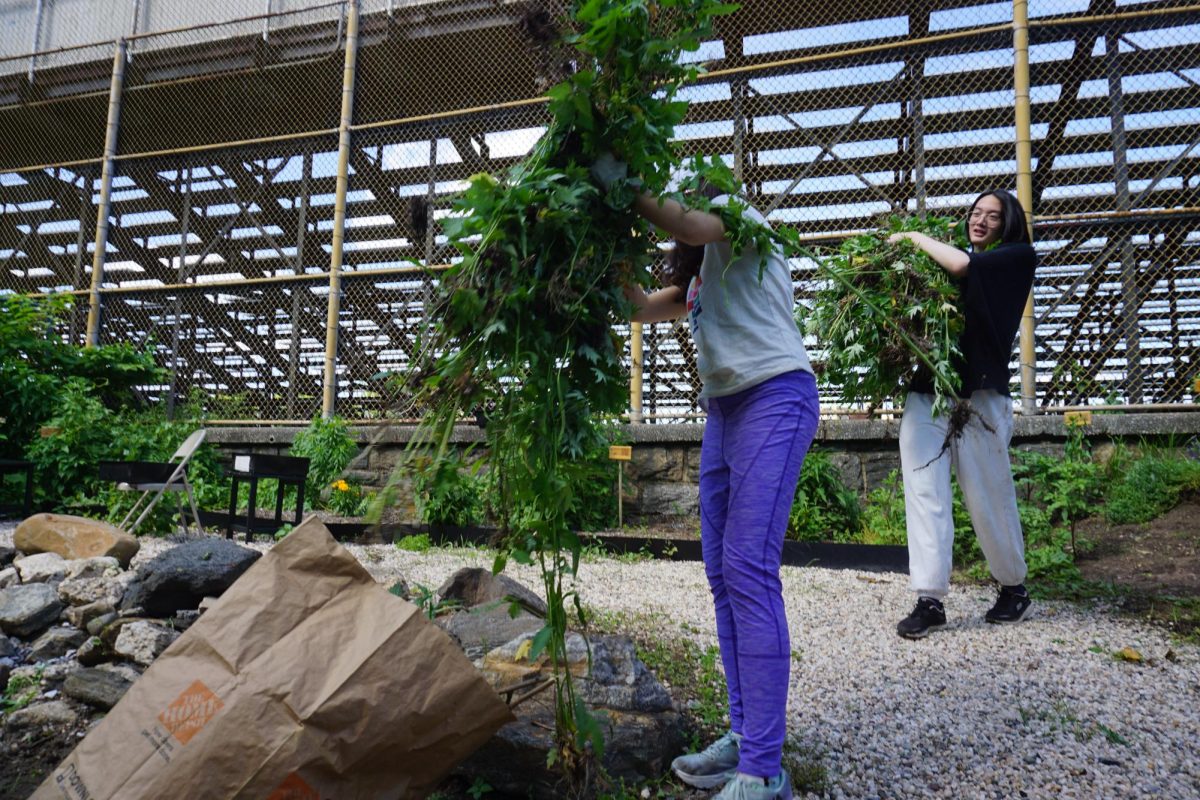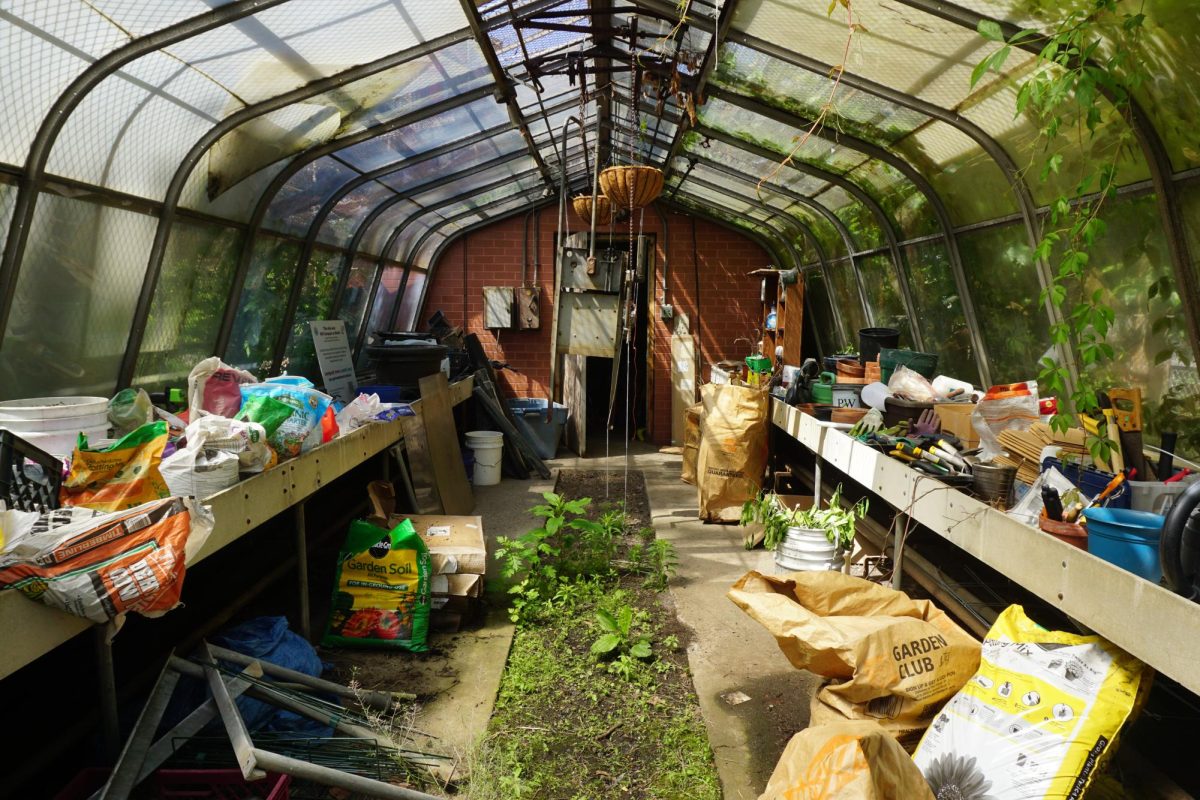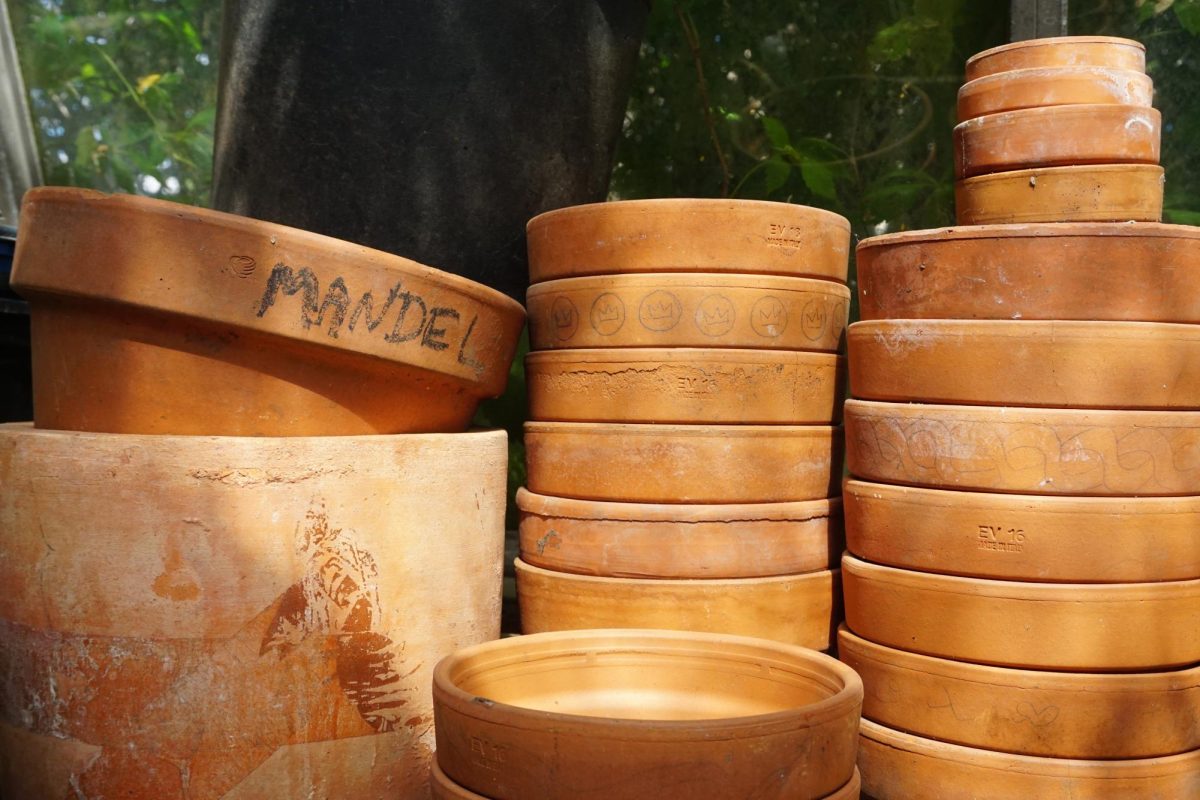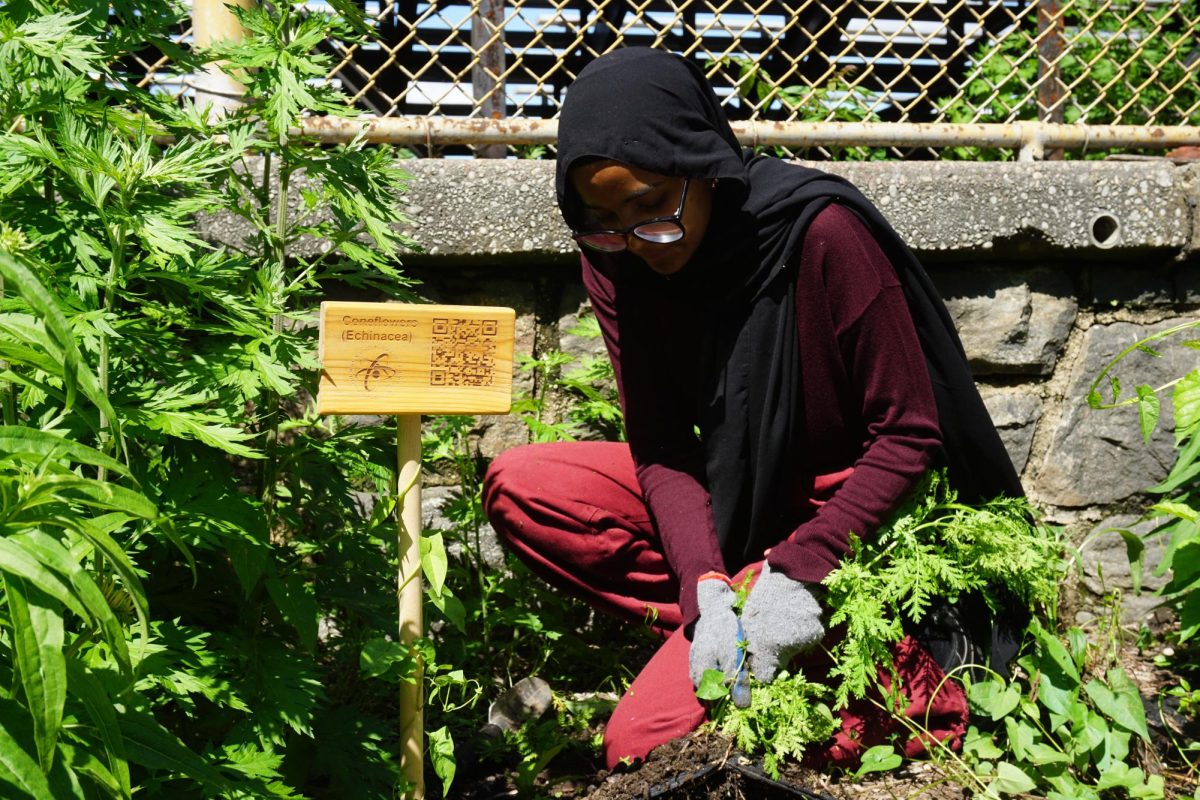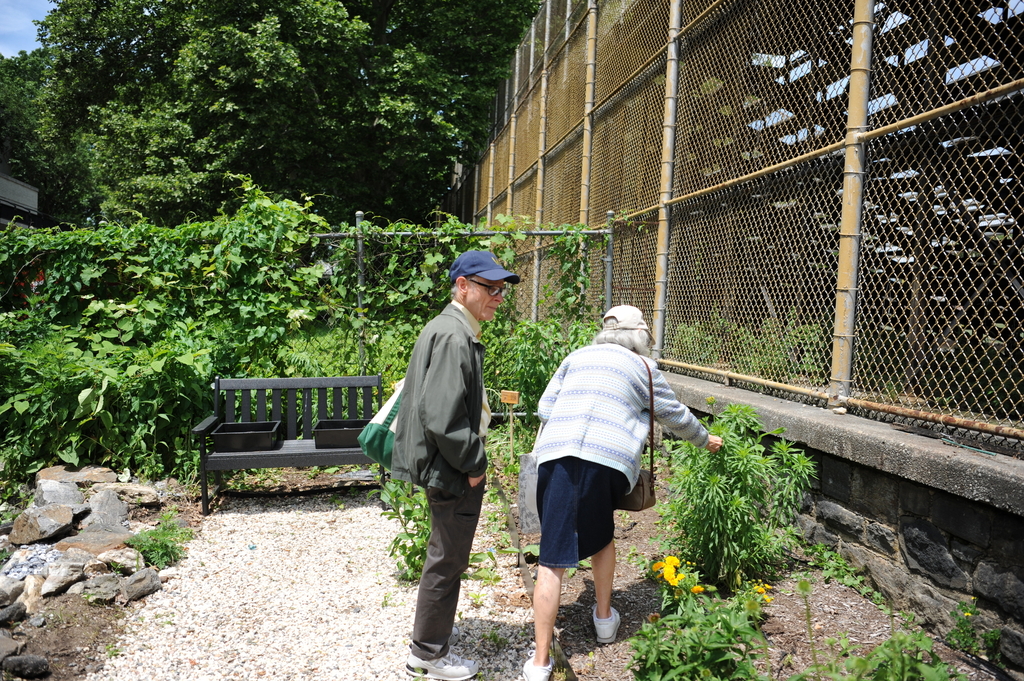IT IS AUTUMN. The trees lining the courtyard have turned brown and yellow; leaves drift gently down onto rows of tables set up for the Bronx Science fall club fair. Amidst the labyrinth of students, signs, and screaming voices, Shahi Mahonaj ’24 and Arianna Hwang ’24 stand at their own table with a poster advertising the Gardening Club. “Are you interested in gardening?” the two co-presidents call out to passing students, waving and offering jolly ranchers. Some students excitedly add their name to the e-mail list, while others shrug and walk on. Many students step forward and examine the poster’s display of photos as Hwang describes her favorite parts of the garden: the lilac bushes, herb mound, and mulberry tree.
Although everyone has heard of Bronx Science’s supposed fourth-floor pool, most students are unaware of the garden’s existence. It’s only a short walk away from the courtyard, past the handball courts and through the teacher parking lot. In the coming weeks, students who had discovered Gardening Club at the club fair joined the group in tending to the garden every Friday.
During the first meeting, Mahonaj gave a tour of the garden to the new members. After dropping off their backpacks by the gate, they file inside and walk down a short pebbled path bordered by lilacs and azaleas. Now in the center of the garden, Mahonaj identified each plant surrounding them. She pointed out the roses and bleeding hearts in front, the hydrangeas, thistles, and ferns lining the greenhouse, and the long grape vine twisting along the opposite wall. Then she led them up a slight incline to the upper level, passing by thyme, mint, lavender, echinacea, asters, and black-eyed susans. A narrow pathway wraps behind the greenhouse (which functions as a storage shed), revealing a hidden cove with fig, plum, and apple trees.
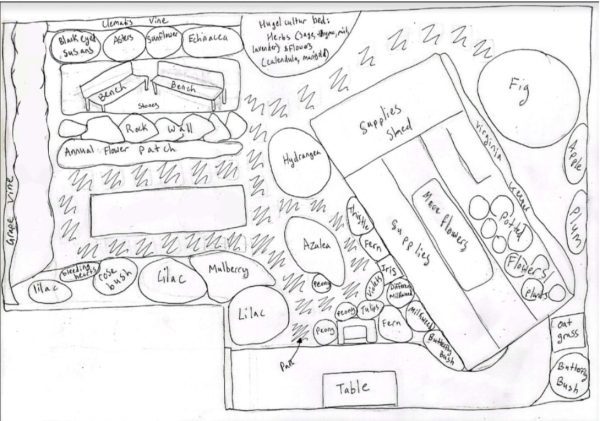
After the new members became oriented, the students armed themselves with gloves and shovels from the greenhouse and marched out to tackle the Japanese knotweed. Japanese knotweed is an invasive species that can grow several inches per day and is extremely durable, with long, thick roots that permeate the soil six feet deep. Even after the body of the plant is pulled out of the soil, it can easily regrow from any roots or leaves left behind.
For this reason, knotweed is illegal to intentionally plant in New York state. However, some took root in the Bronx Science garden a few years ago, and it has incessantly thrived ever since. After years of researching methods of restraint, none of which were realistic, the school administration and the Bronx Science Foundation stepped in last spring to help address this problem.
The Foundation funded a major renovation of the garden, removing much of the topsoil from the center, laying down a weed barrier, and covering it with a thick layer of pea gravel. The tarp and pebbles acted as a barricade blocking sunlight and discouraging growth. Knotweed’s abundance has decreased since the renovation, although it still persists in the garden.
Much of this work was done by the Assistant Principal of the Physical Education Department, Mr. Michael McGrath, who also led a team of volunteers in repainting the greenhouse and built raised beds to compensate for the lost usable soil space. Other recent improvements include acquiring a new compost bin, arranging benches on the upper level, and creating informative signposts with QR codes identifying each plant.
“The purpose was to rejuvenate the garden for students, teacher and class use,” explained Mr. McGrath. He added that his work aligned with the Department of Education commitment to celebrating green spaces in schools. “We are trying to bring awareness to the school garden during Physical Education classes and during our NYC DOE climate change days.”
Back at the Gardening meeting, students strive to keep the garden in good condition. They wipe down the benches and rip out knotweed that has managed to push through the gravel. They laugh and joke as they uproot the weeds, combine their strength to pull out particularly large ones, and unearth worms or buried trinkets in the soil. It may seem like hard work, but Gardening meetings usually last until the sun begins to set, long after the official end time of 3:45 p.m. As people eventually begin to leave, they return to the greenhouse to put back their gloves and wrap up the meeting.
IT IS WINTER. The garden is now dead and barren; snow dusts the pebbled pathways and adorns the fig and apple trees. During this long stretch of months, Gardening Club either remains indoors with lessons about botany or meets inside the greenhouse in order to organize its endless array of supplies: trowels, gloves, pruning shears, meter sticks, watering cans, bags of soil and fertilizer, trays of seeds, ceramic pots, spools of string.
The interior of the greenhouse is one of the few things that was untouched by the Foundation’s renovation last spring. Although most alumni from even just a couple years ago would hardly recognize the garden post-renovation, they would feel a striking familiarity after entering the greenhouse door. Its rows of shelves still hold leftover supplies from decades ago, including worn bags of soil and ancient seed packets. Its structure, too, has been left to deteriorate. Hwang described the greenhouse as “semi-dilapaleted-not-so-functioning,” referring to its missing windowpanes and broken electrical system.
There is no doubt, however, that the greenhouse holds a certain charm and element of nostalgia. Memories leak out of the building’s cracked roof and rusted pipes, trickling into stacks of old graffitied ceramic pots and pooling onto the concrete floor.
Before the Gardening Club existed, the greenhouse and garden were maintained by the Horticulture class. Bronx Science offered this course for many years, although it is no longer an option today. Besides the valuable experience of tending to the school garden, the class also embarked on field trips to local parks and farmers’ markets. In the words of an article in the 1996 Bronx Science yearbook The Observatory, Horticulture “enabled students to learn outdoors and was popular among those who liked first-hand research in the environment.”
At some point during the early 2000s, responsibility of the garden was transferred to the Gardening Club, under the advisory of a dedicated science teacher named Dr. Julie Mankiewicz. The 2016 yearbook boasts two pages dedicated to exploring the garden and the work that the club had done. “We harvested ripe plants, we composted dead plants to provide nutrients for the soil, we removed weeds, we cleaned and organized, and we watered plants in the memorial garden,” said Esther Lam ’17 when interviewed at the time. “Gardening is a fulfilling experience that takes us out of our comfort zone and into an atmosphere where we can de-stress from the school week.”
After the transtition to virtual learning during the winter of 2020 at the height of the Coronavirus pandemic, the garden became abandoned and uncared for. The club continued their meetings on Zoom, but was unable to visit the school garden in person.
It was in this online format that Mahonaj and Hwang, the current co-presidents, first entered the Gardening community as ninth graders. “Sometimes we talked about plants and the garden, but most of the time, we talked about anything and everything,” remembered Mahonaj. “It was truly a time for us to reflect on the week, and it was not uncommon that the meetings went until five or six p.m.” The group still made an effort to continue gardening as much as they could, encouraging each other to grow plants in their own homes, and, when COVID-19 restrictions lessened, occasionally meeting in person while others joined on a livestream.
“No offense, but Gardening Club and being online don’t mesh really well,” added Hwang. “It just sounds counterintuitive, yet it somehow worked.”
When Hwang and Mahonaj were finally able to return to in-person learning and visit the garden for the first time in fall of 2021, the land had become completely wild and overgrown. Japanese knotweed had infested all corners of the garden; even the plants that weren’t weeds had grown uncontrollably. It required a collective effort and many months of hard labor to transform the garden back into decent shape. Only after this initial work was done could the Bronx Science Foundation enact its major renovation a couple years later.
Another large post-pandemic project was reorganizing the greenhouse and taking stock of all of its supplies. Besides the necessities in the greenhouse’s main room, a small closet in the back stores larger tools such as shovels, rakes, and buckets. This closet is fondly referred to as ‘The Murder Shed’ – a tradition so old, no one knows its origins – and dozens of faded signatures from former club members and Horticulture students are etched into the door’s splintered wood. Mahonaj, Hwang, and several others added their names towards the end of this winter, cementing their legacy in the Bronx Science greenhouse.
IT IS SPRING. As Bronx Science students sit trapped inside our boxy brick building for Advanced Placement and Regents exams, a natural haven blooms just outside. Leafy branches stretch through holes in the garden’s wire fence; soil spills out onto the neighboring concrete. In the heart of New York City – and during the height of high school’s most academically tiring season – our school garden is unabashedly alive.
Spring is also a time of several important school events connecting members across the Bronx Science community, including those who do not currently attend the school. The first week of June brought together people in all walks of life who did, do, or will dedicate themselves to the garden, through events such as Alumni Day, the Spring Open House, and the Gardening Club’s end-of-year celebration.
On Sunday, June 2nd, 2024, Alumni Day kicked off the week by welcoming back hundreds of former graduates spanning almost eight decades of Bronx Science history. As part of the festivities, the garden was open to tours led by Mahonaj and others. Alumni of all ages wandered through the rocky paths, peeked into the greenhouse, and admired the plants and flowers. Some had tended to the garden during their own time at Bronx Science and shared excitedly about their memories of taking Horticulture or growing trees in the greenhouse.
Three days later, on Wednesday, June 5th, 2024, Mahonaj stands in a crowded gymnasium, equipped with the same poster from the fall club fair and a bowl full of mulberries fresh from the garden. This time, she is surrounded by prospective seventh graders and their families for the school’s annual June Open House for Prospective Students. Kids sample mulberries, staining their fingers purple, while Mahonaj ignites an interest in both the garden and the school. For Mahonaj, this moment brings her full circle. She, too, had attended a Bronx Science open house as a middle schooler. Now, in her last remaining days before graduation, she is the one reaching out towards future generations to ensure the club’s – and therefore, the garden’s – longevity.
Closing out the week, Friday, June 7th, 2024, was a bittersweet day for Mahonaj and Hwang alike. It was the final Gardening meeting of the 2023 – 2024 academic year, and one of their last moments spent in the Bronx Science garden. After a surprise party thrown by the younger members, complete with soda, doughnuts, and samosas, Mahonaj and Hwang gave short speeches to express their love for the garden.
Reflecting back, Mahonaj said that the “serene-like quality” was her favorite part of the garden. “When I would tend to the garden in the summer or even during the weekends, I would always take a moment to sit back and just watch nature unfold in front of me. It brought such ease into my heart just seeing different flora flourish and seeing wildlife interact with the plants.”
Looking towards the future, she also expressed hope that the close community revolving around the garden would endure. “I have met some of the most wonderful people Bronx Science has to offer simply because of the Gardening Club,” Mahonaj said. “I hope future generations will also spend an exorbitant amount of time in front of the garden gate simply because they don’t want to stop talking to each other after meetings, just as I felt.”
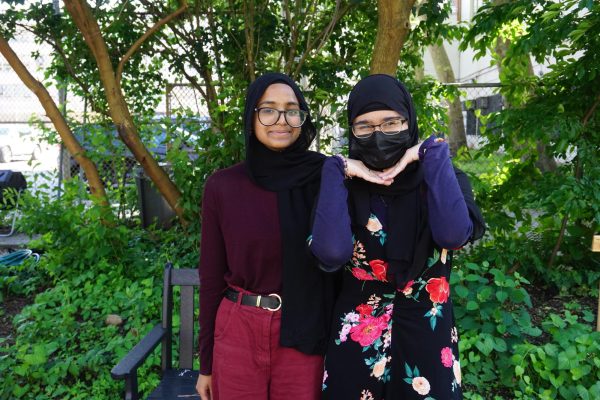
Hwang offered more practical advice. “We still need to fix the greenhouse,” she asserted. “Hopefully, it will be up and running – instead of being a storage room – ten years down the line when I come back for Alumni Day.”
Hwang also addressed the prolonged battle against Japanese knotweed, joking, “We really need to get rid of those weeds and pests with some sort of magic or something.”
For the two co-presidents, this last meeting represents the end of their time at Bronx Science, but it is also a new beginning. Mahonaj’s and Hwang’s contributions throughout the past four years will allow the garden to thrive long after they leave, similar to the ways in which October’s falling leaves nourish the soil so that new plants can grow again in May. Both the plants and the people of the Bronx Science garden make up an ecosystem that enables the garden and its community to flourish.
While the transfer of leadership closes one cycle, the start of summer opens another. Students will continue to come to the school during July and August to tend to the plants and maintain the garden. Flowers will bloom and fade, rain will fall and then evaporate upwards, and kids will run in and out of the greenhouse door as the days gradually begin to shorten and cool. All too soon, it will be autumn again.
In the heart of New York City – and during the height of high school’s most academically tiring season – our school garden is unabashedly alive.

